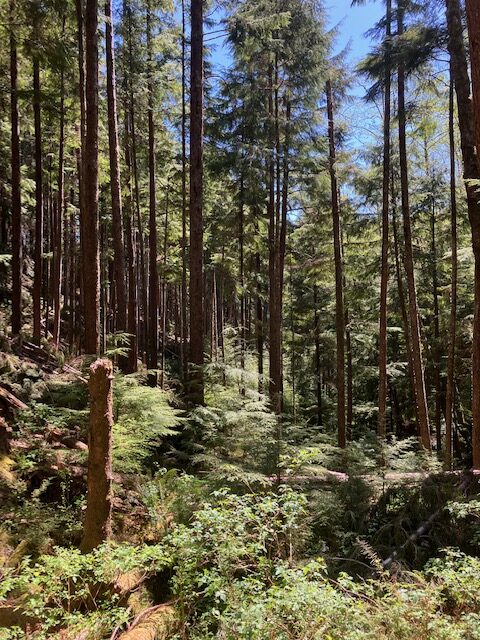This winter, North Coast Land Conservancy’s stewardship team completed the last phase of a five-year forest restoration project on Boneyard Ridge, a roughly 340-acre habitat reserve atop Tillamook Head in Clatsop County.


“Our approach is to encourage as diverse a forest as possible, so the trees, plants, and animals can adapt to a changing environment as they need to,” Stewardship Director Melissa Reich says.
NCLC purchased Boneyard Ridge in 2018 with the intent to restore it from a tree farm to a healthy forest and create a connected conservation corridor from Ecola State Park to Circle Creek Conservation Center to the Necanicum River. The team started the project in 2019, tackling this massive effort in three distinct phases involving different units of the forest.
In general, the project involved thinning 212 acres of overstocked (or overly dense) forest; creating gaps (or openings) for wildlife habitat; and planting for species diversity. However, the team prescribed varied thinning treatments for each forest unit in Boneyard Ridge based on the age and density of the trees on the landscape.
The goal was to create natural forest conditions, considering how the forest might have developed over time without industrial logging—for example, using other coastal forests that were not logged and replanted as a guide to the types of disturbances that shape these forests.
On this part of the Oregon Coast, wind events and landslides are the most common types of natural disturbance, as opposed to fire, which more greatly affects areas east of the coastal Sitka-spruce zone.
“We’re mimicking what wind does naturally to jumpstart the restoration project and set the forest on the right trajectory to becoming healthy and robust,” Melissa says.

A Model for Future Forest Restoration
Some important elements of a healthy forest include diverse tree and plant species; a variety of tree-age cohorts; and multiple tree-canopy layers that are varied in composition across the forest. That means having clusters of trees and also gaps without tree canopy, which creates a more diverse understory where plants can flourish, along with an array of wildlife that thrives in these conditions.
In Phase I of the project, started in 2019, NCLC did a thinning of young, tightly spaced trees and created small gaps in 65 acres of Boneyard Ridge. The team also constructed habitat piles with the downed wood and planted bigleaf maple and western redcedar to increase tree diversity.
Phase II, which took place in 2022, involved an older stand that was planted in 1960. Because of wind and natural disturbances, a good portion of that area already had some of the qualities of a natural mature forest. NCLC focused on thinning only about 40 acres of this stand of trees that were dog-hair Hemlock stands, and then followed up with larger gaps, planting and snag creation. All of the trees in this area were individually selected for falling and left onsite.
Finally, this past winter, during Phase III, NCLC addressed another younger 85-acre stand in the western portion of the reserve, thinning the overpopulated trees and creating even larger gaps of up to .25 acre in size. These larger gaps were selected in more open areas of the stand where wildlife, including elk, deer and birds had been seen actively using these openings. To further diversify the habitat, NCLC’s stewardship team will add nectar plant species to the large gaps this spring.


In all of these areas, there already is seed in the forest floor. Opening up gaps and allowing sunshine to filter through will naturally prompt the trees and plants to grow back and create a more healthy forest.
This is the first active forest restoration project NCLC has completed. Prior, the stewardship team has done passive restoration in our forested habitat reserves—such as removing invasive species—and monitoring.
“I got to meet with so many experts and partners and learn so much,” Melissa says. “We’re monitoring to see how the forest is responding to our treatments. We’re in a really good position to be thinking about larger-scale management and restoration of our forests.”
Comments